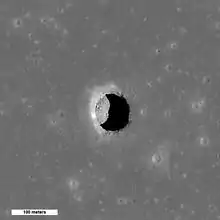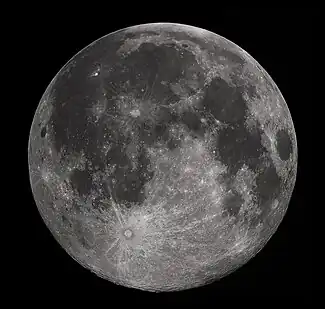
Lunar lava tubes are lava tubes on the Moon formed during the eruption of basaltic lava flows. When the surface of a lava flow cools, it hardens and the lava can channel beneath the surface in a tube-shaped passage. Once the flow of lava diminishes, the tube may drain, forming a hollow void. Lunar lava tubes are formed on sloped surfaces that range in angle from 0.4° to 6.5°.[1] These tubes may be as wide as 500 metres (1,600 ft) before they become unstable against gravitational collapse. However, stable tubes may still be disrupted by seismic events or meteoroid bombardment.[2]
The existence of a lava tube is sometimes revealed by the presence of a "skylight", a place in which the roof of the tube has collapsed, leaving a circular hole that can be observed by lunar orbiters.[3][4]
Observational evidence

An area displaying a lava tube and rilles is the Marius Hills region (14°4′20.83″N 56°44′57.49″W / 14.0724528°N 56.7493028°W).[1] In 2008, an opening to a lava tube in this area may have been discovered by the Japanese Kaguya spacecraft.[5] The skylight was photographed in more detail in 2011 by NASA's Lunar Reconnaissance Orbiter, showing both the 65-meter-wide pit and the floor of the pit about 36 meters below.[4][6] Additionally, the Hadley Rille may have been a partly roofed lava channel, some parts of which have since collapsed.[7] There may also be lava tubes in the Mare Serenitatis.[8][9][10][11]
The Lunar Reconnaissance Orbiter has imaged over 200 pits that show the signature of being skylights into subsurface voids or caverns, ranging in diameter from about 5 m (16 ft) to more than 900 m (3,000 ft),[12] although some of these are likely to be post-flow features rather than volcanic skylights.[13]
The ISRO Chandrayaan-1 orbiter imaged a lunar rille formed by an ancient lunar lava flow with an uncollapsed segment indicating the likely presence of a lava tube near the lunar equator. The tunnel measures about 2 km (1.2 mi) in length and 360 m (1,180 ft) in width.[14][15]
Gravitometric observations by the GRAIL spacecraft suggest the presence of lunar lava tubes with widths of over 1 km. Assuming a width-to-height ratio of 3:1, such a structure can remain stable with a ceiling that is 2 m (6.6 ft) thick.[16]

Proposed exploration
Several groups have proposed robotic missions to explore lunar and Martian lava tubes.[3][17]
The "Moon Diver" mission led by Laura Kerber proposes to send the two-wheeled AXEL extreme-terrain rover developed at NASA-JPL into a lunar pit in order to investigate the history of the lunar mare and flood basalt eruptions.[18][19]
In 2019, the European Space Agency launched a campaign through the ESA's Open Space Innovation Platform (OSIP) to evaluate innovative proposals aimed at the exploration, documentation and 3D mapping of volcanic cavities on the Moon. Two complementary studies have been selected, the Descent And Exploration in Deep Autonomy of Lava Underground Structures (DAEDALUS) Sphere and the RoboCrane.[20] DAEDALUS is a prototype designed by the University of Wurzburg (Germany), the Jacobs University (Germany), the University of Padua (Italy), the INAF-Osservatorio di Padova (Italy) and the VIGEA-Virtual Geographic Agency (Italy). This prototype is equipped with several components capable of performing a high-definition 3D mapping during the descent and moving autonomously within a lava tube. This system is in fact equipped with LIDAR and stereoscopic cameras to guarantee almost total coverage in order to acquire data in any condition.
Sites for human habitats

Lunar lava tubes may potentially serve as enclosures for human habitats.[5][8][21] Tunnels larger than 300 metres (980 ft) in diameter may exist, lying under 40 metres (130 ft) or more of basalt, with a stable temperature of −20 °C (−4 °F).[22] These natural tunnels provide protection from cosmic radiation, solar radiation, meteorites, micrometeorites, and ejecta from impacts. They are insulated from the extreme temperature variations on the lunar surface and could provide a stable environment for inhabitants.[23]
Lunar lava tubes are typically found along the boundaries between lunar mares and highland regions. This would give ready access to: elevated regions, for communications; basaltic plains, for landing sites and regolith harvesting; and underground mineral resources.[24]
See also
References
- 1 2 Greeley, Ronald (December 1971), "Lava Tubes and Channels in the Lunar Marius Hills", The Moon, 3 (3): 289–314, Bibcode:1971Moon....3..289G, doi:10.1007/BF00561842, hdl:2060/19710008532, S2CID 122121114
- ↑ Cruikshank, D. P.; Wood, C. A. (March 1972), "Lunar Rilles and Hawaiian Volcanic Features: Possible Analogues", The Moon, 3 (4): 412–447, Bibcode:1972Moon....3..412C, doi:10.1007/BF00562463, S2CID 120469722
- 1 2 Huber, S. A.; et al. (2014), "Astrobotic Technology: Planetary Pits and Caves for Science and Exploration", Annual Meeting of the Lunar Exploration Analysis Group, abstract 3065 (PDF), retrieved 24 January 2016.
- 1 2 Clark, Liat (9 February 2011), "First underground cave photographed on the moon", Wired UK, archived from the original on 10 February 2011, retrieved 24 January 2016
- 1 2 Handwerk, Brian (October 26, 2009), "First Moon "Skylight" Found -- Could House Lunar Base?", National Geographic, archived from the original on October 29, 2009, retrieved 2011-01-27
- ↑ "The Marius Hills hole is a possible skylight". Photojournal. Jet Propulsion Laboratory. 2010-03-01. Retrieved 28 June 2011.
- ↑ Greeley, Ronald (May 1971), "Lunar Hadley Rille: Considerations of Its Origin", Science, 172 (3984): 722–725, Bibcode:1971Sci...172..722G, doi:10.1126/science.172.3984.722, hdl:2060/19710005212, PMID 17780969, S2CID 46616037
- 1 2 Coombs, Cassandra R.; Hawke, B. Ray (September 1992), "A search for intact lava tubes on the Moon: Possible lunar base habitats", In NASA. Johnson Space Center, The Second Conference on Lunar Bases and Space Activities of the 21st Century (SEE N93-17414 05-91), vol. 1, pp. 219–229, Bibcode:1992lbsa.conf..219C
- ↑ O'Malley, Rich (January 4, 2010). "Scientists eye moon colonies — in the holes on the lunar surface". New York Daily News. Archived from the original on 2011-07-14. Retrieved 13 October 2011.
- ↑ Plait, Phil (5 March 2010), "Spelunking the Lunar Landscape", Bad Astronomy, Discover Magazine, retrieved 24 January 2016
- ↑ Atkinson, Nancy (2010-06-17), "Very Clever! LRO Views Huge Lava Tube Skylight in Mare Ingenii", Universe Today, retrieved 13 October 2011
- ↑ Dvorsky, George (October 18, 2014). "Could This Lunar Cave Provide Shelter for a Future Moon Colony?". io9 / Gizmodo. Retrieved 24 January 2016.
- ↑ Wagner, Robert V.; Robinson, Mark S. (July 15, 2014), "Distribution, formation mechanisms, and significance of lunar pits", Icarus, 237: 52–60, Bibcode:2014Icar..237...52W, doi:10.1016/j.icarus.2014.04.002.
- ↑ Arya, A. S.; et al. (February 25, 2011), "Detection of potential site for future human habitability on the Moon using Chandrayaan-1 data", Current Science, 100 (4), retrieved 2016-12-19.
- ↑ "After water, now Indian scientists find cave on Moon", Silicon India News, February 8, 2010, retrieved 2016-01-24.
- ↑ Blair, David M.; et al. (January 15, 2017), "The structural stability of lunar lava tubes", Icarus, 282: 47–55, Bibcode:2017Icar..282...47B, doi:10.1016/j.icarus.2016.10.008, S2CID 1259891371
- ↑ Ximenes, S. W.; Elliott, J. O.; Bannova, O. (2012). "Defining a Mission Architecture and Technologies for Lunar Lava Tube Reconnaissance". Earth and Space 2012. p. 344. doi:10.1061/9780784412190.038. ISBN 978-0-7844-1219-0.
- ↑ Kerber, Laura (April 2, 2018). "Lecture: Moon Diver Mission Concept - Descending into a Moon Cave to Better Understand the Solar System's Largest Volcanic Eruptions". KISSCaltech. Retrieved 2018-06-24.
- ↑ Kerber, Laura (April 3, 2018). Moon Diver Mission Concept. KISSCaltech. Retrieved 2018-06-24.
- ↑ "DAEDALUS". www.informatik.uni-wuerzburg.de (in German). Retrieved 2022-06-05.
- ↑ O'Neill, Ian (October 27, 2009), "Living in Lunar Lava Tubes", Discover News, archived from the original on 23 October 2012, retrieved 1 January 2012
- ↑ York, Cheryl Lynn; et al. (December 1992), "Lunar lava tube sensing", Lunar and Planetary Institute, Joint Workshop on New Technologies for Lunar Resource Assessment, pp. 51–52, Bibcode:1992ntlr.work...51Y
- ↑ De Angelis, G.; et al. (November 2001), "Lunar Lava Tubes Radiation Safety Analysis", Bulletin of the American Astronomical Society, 33: 1037, Bibcode:2001DPS....33.1003D
- ↑ Walden, Bryce E.; et al. (January 1998), "Utility of Lava Tubes on Other Worlds", Workshop on Using In Situ resources for Construction of Planetary Outposts, p. 16, Bibcode:1998uisr.work...16W
